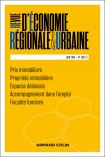
REVUE D'ÉCONOMIE RÉGIONALE ET URBAINE (1/2024)
Pour acheter ce numéro, contactez-nous
Recevez les numéros de l'année en cours et accédez à l'intégralité des articles en ligne.
Cet article propose différentes métriques pour évaluer la proximité organisée. La textométrie est notamment utilisée pour explorer un corpus d’entretiens semi-directifs afin d’appréhender la logique de similitude qui relie les acteurs du secteur logistique en Région Occitanie. Actuellement, la coordination entre secteur logistique et territoire repose sur des institutions telles que le Cluster Tenlog. Cependant, la création seule de ces instances ne peut répondre aux défis du secteur logistique, étant donné que les acteurs ont peu d’objectifs collectifs. Ainsi, la construction d’un langage commun, de modes de travail et d’une confiance mutuelle joue un rôle central dans les processus de coordination. La gouvernance logistique en Région Occitanie, dynamique et transactionnelle, constitue donc un exemple pertinent pour tester la méthodologie proposée.
This article suggests multiple methods to approach organised proximity. A set of semi-structured interviews is analysed using textometry to explore the similarities between stakeholders in the logistics sector. A novel methodological approach provides quantifiable metrics for two essential logics: "similarity", which refers to a mental alignment with shared ideas, and "belonging", defined as the process of integrating individual actors into a unified network. In broadening the scope of organised proximity research, this study unveils a comprehensive framework that fuses textometry and network analysis. This integration offers a multidimensional viewpoint for understanding and gauging stakeholder interactions, significantly enriched by the introduction of a new entropy indicator. Public actors are engaged in promoting innovative, eco-friendly practices in logistics to reduce greenhouse gas emissions and enhance spatial equity. They seek to establish themselves as coordinators in the sector, shaping strategies that address the collective needs of private actors. As it stands, institutions like the Tenlog Cluster may facilitate coordination. However, these organisations only partially meet the challenges in the logistics sector given that stakeholders frequently have disparate interests and objectives. As a result, coordination relies on institutions and associations such as the Tenlog Cluster. However, the creation of these entities cannot fully address the challenges of the logistics sector, as stakeholders have limited shared interests and objectives. Building a common language, working habits, and mutual trust may also improve the coordination process. The dynamic and transactional nature of logistical governance in the Occitanie region provides a relevant example establishing a connection between textometry, network analysis, and organised proximity. Going beyond theoretical contributions, this research offers actionable tools for logistics stakeholders. These tools can inform more effective policy-making by identifying areas where enhanced coordination can yield operational benefits.

